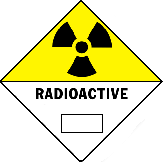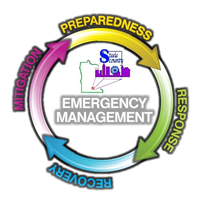 A nuclear blast is an explosion with intense light and heat, a damaging pressure wave, and widespread radioactive material. Contamination of air, water, and ground surfaces can occur for miles around. A nuclear device can range from a weapon carried by an intercontinental missile or a small portable nuclear device transported by an individual. The extent, nature, and arrival time of these hazards is dependent on:
A nuclear blast is an explosion with intense light and heat, a damaging pressure wave, and widespread radioactive material. Contamination of air, water, and ground surfaces can occur for miles around. A nuclear device can range from a weapon carried by an intercontinental missile or a small portable nuclear device transported by an individual. The extent, nature, and arrival time of these hazards is dependent on:
- Size of the device. A more powerful bomb will produce more distant effects.
- Height above the ground the device was detonated. This will determine the extent of blast effects.
- Nature of the surface beneath the explosion. Some materials are more likely to become radioactive and airborne than others. Flat areas are more susceptible to blast effects.
- Existing meteorological conditions. Wind speed and direction will affect arrival time of fallout; precipitation may wash fallout from the atmosphere.
Nuclear radiation cannot be seen, smelled, or otherwise detected by normal senses. Radiation can only be detected by radiation monitoring devices. This makes radiological emergencies different from other types of emergencies, such as floods or hurricanes.
Even if individuals are not close enough to the nuclear blast to be affected by the direct impacts, they may be affected by radioactive fallout. Any nuclear blast results in some fallout. Blasts that occur near the earth’s surface create much greater amounts of fallout than blasts that occur at higher altitudes. The tremendous heat produced by a nuclear blast causes an up-draft of air, drawing vaporized dirt particles. The familiar mushroom cloud is formed. As the heat diminishes, the vaporized radioactive materials condense on the particles and fall back to Earth. The phenomenon is called radioactive fallout.
Fallout material decays over a long period of time, and is the main source of residual nuclear radiation. Fallout may be carried by wind currents for hundreds of miles if the right conditions exist. Monitoring can project the fallout arrival times, which will be announced through official warning channels. However, any increase in surface build-up of gritty dust and dirt should be a warning for taking protective measures.
Decay rates of the radioactive fallout are the same for any size nuclear device. However, the amount of fallout will vary based on the size of the device and its proximity to the ground. Therefore, it might be necessary for those in the areas with highest radiation levels to shelter for up to a month. The heaviest fallout would be limited to the area at or downwind from the explosion, and 80 percent of the fallout would occur during the first 24 hours. People in most of the areas that would be affected could be allowed to come out of shelter within a few days and, if necessary, evacuate to unaffected areas.
Protection from radioactive fallout requires taking shelter in an underground area or in the middle of a large building. Remember that any protection, however temporary, is better than none at all. The three factors for protecting oneself from radiation and fallout are distance, shielding, and time:
- Distance – the more distance between you and the fallout particles, the better. An underground area such as a home or office building basement offers more protection than the first floor of a building. A floor near the middle of a high-rise may be better, depending on what is nearby at that level on which significant fallout particles would collect. Flat roofs collect fallout particles so the top floor is not a good choice, nor is a floor adjacent to a neighboring flat roof.
- Shielding – the heavier and denser the materials – thick walls, concrete, bricks, books and earth – between you and the fallout particles, the better.
- Time – fallout radiation loses its intensity fairly rapidly. In time, you will be able to leave the fallout shelter. Radioactive fallout poses the greatest threat to people during the first two weeks, by which time it has declined to about 1 percent of its initial radiation level.
To prepare for a nuclear blast, you should do the following:
- Find out from officials if any public buildings in your community have been designated as fallout shelters. If none have been designated, make your own list of potential shelters near your home, workplace, and school. These places would include basements or the windowless center area of middle floors in high-rise buildings, as well as subways and tunnels.
- If you live in an apartment building or high-rise, talk to the manager about the safest place in the building for sheltering and about providing for building occupants until it is safe to go out.
- During periods of increased threat increase your disaster supplies to be adequate for up to two weeks.
Taking shelter during a nuclear blast is absolutely necessary. There are two kinds of shelters – blast and fallout. Blast shelters are specifically constructed to offer some protection against blast pressure, initial radiation, heat, and fire. But even a blast shelter cannot withstand a direct hit from a nuclear explosion. Fallout shelters do not need to be specially constructed for protecting against fallout. They can be any protected space, provided that the walls and roof are thick and dense enough to absorb the radiation given off by fallout particles.
If an attack warning is issued:
- Take cover as quickly as you can, below ground if possible, and stay there until instructed to do otherwise.If you are caught outside, lie flat on the ground and cover your head. If the explosion is some distance away, it could take 30 seconds or more for the blast wave to hit.
- Do not look at the flash or fireball – it can blind you.
- Listen for official information and follow instructions.
In addition to other effects, a nuclear weapon detonated in or above the earth’s atmosphere can create an electromagnetic pulse (EMP), a high-density electrical field. An EMP acts like a stroke of lightning but is stronger, faster, and shorter. An EMP can seriously damage electronic devices connected to power sources or antennas. This includes communication systems, computers, electrical appliances, and automobile or aircraft ignition systems. The damage could range from a minor interruption to actual burnout of components. Most electronic equipment within 1,000 miles of a high-altitude nuclear detonation could be affected. Battery-powered radios with short antennas generally would not be affected. Although an EMP is unlikely to harm most people, it could harm those with pacemakers or other implanted electronic devices.
Updated 10-Feb-2020
